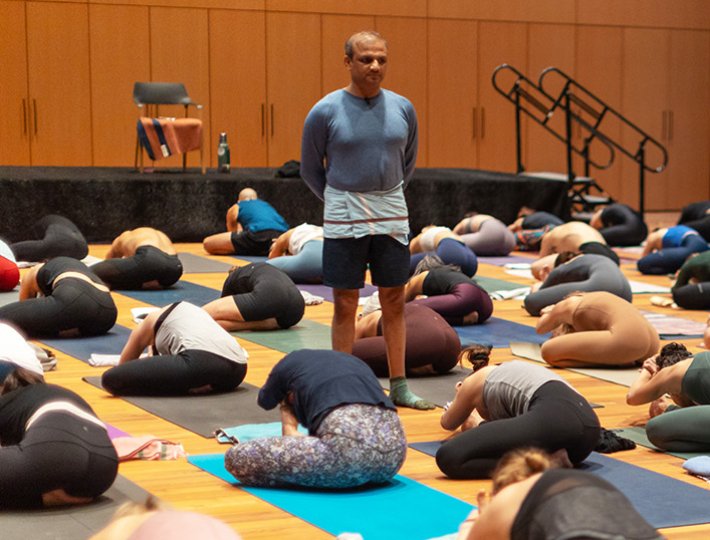In Ayurveda, the Sanskrit word ojus is synonymous with resistance to disease. There are two types of ojus, which are formed in the womb and fully perfected by the eighth month of pregnancy, called para-ojus and apara-ojus.
Within para-ojus, there are exactly eight drops, which are located in the heart and the great vessels surrounding the heart. These eight drops are with you for your whole life, and their purpose is to keep the the body free from diseases. The textbooks say that if this ojus is reduced, the person’s life is threatened, so it cannot be replaced or refilled. Once lost, it’s gone for good.
The second kind, apara-ojus, is present at the time of birth, but also keeps accumulating as you grow. This quantity is said to be about one palmful of your own hand, depending on the health of your tissues. In Ayurveda, we have seven classifications of tissues: plasma, blood, muscle, fat, bone, bone marrow, and reproductive. Each of these tissues—when functionally, quantitatively, and qualitatively healthy—contributes to the formation and maintenance of this second type of ojus. Ideally, if you’re healthy, you’re collecting apara-ojus just by living, and it’s always working because you are fighting diseases throughout your entire life.
How Modern Science Factors In
There are some interesting parallels between what modern science and Ayurveda say about the immune system. The thymus gland, located right in front of the heart between the lungs, is very large when we are in the womb. The cells that are important to immunity are produced in the liver and the spleen. These cells, called lymphocytes, migrate to the thymus gland, get “schooled” into knowing what is the body and what is not, and become T lymphocytes, also known as T cells. That means these cells are able to recognize anything in the body that is abnormal, like foreign bacteria or viruses. There are a limited number of these cells because after the first year of life, the thymus gland becomes completely rudimentary. This makes sense, because in Ayurveda, we also know that there are a finite number of para-ojus cells and once they’re gone, we die.
The other types of immune cells are distributed all over the body and are made up of several different subtypes, such as B cells and natural killer cells. They’re not quite as intelligent or trained as the T cells, but once the body recognizes something as a foreign material, these types of cells attack and destroy it. They are much higher in quantity, so in a sense, they parallel the apara-ojus.
Enhance Your Immune System Naturally
In Ayurveda, there are three main ways to strengthen the ojus for optimal health.
1. Lifestyle Choices
Since you can only improve the functionality of the para-ojus, not replenish it, lifestyle choices seem to be the most critical for keeping it well-functioning. What depletes the para-ojus is either physical or mental overexertion. So how you physically behave and your mindset are vital. The more integrated and self-controlled you are, the more vibrant and strong your ojus will be. Additionally, exercising regularly (but not overdoing it) is very important for immunity, because the more vibrant and active your tissues are, the more vibrant and active your ojus.
2. Herbal Options
Amalaki, also known as Indian gooseberry, is one the most important herbs that keeps the ojus in tune. It’s one of the world’s richest sources of vitamin C, which is very important for immunity. Research indicates that amalaki reduces oxidative stress on the body. It is often put into a preparation called chyavanaprash for daily consumption. This poly-herbal formula includes more than 35 other ingredients and is meant to increase the metabolism of all the tissues in the body. One herb cannot address all the immune requirements of the body. So they have made it into this jam, which has the primary herb as well as some secondary herbs to enhance its actions.
You can buy chyavanaprash many places, but you want to make sure that it is from a good source. Amalaki is expensive, so sometimes it’s substituted with other ingredients. So it’s always a good idea to check and confirm that it actually contains amalaki. Some companies claim it’s organic, but that might just indicate it’s missing key ingredients because not all of them can be sourced organically.
Related: 4 Ways to Stay Healthy Through the Season
Another major immunity herb is ashwagandha, which is very popular right now. Traditionally, this is used for males in a poly-herbal formula called ashwagandha lehyam, which is another product Ayurveda recommends to take daily. Many Ashtanga yoga practitioners will take chyavanaprash before their yoga practice, and ashwagandha lehyam after their practice.
For women, shatavari is the main female ojus-building herb. It’s usually administered in the form of a ghee because it’s better absorbed with fat.
3. Food
Fresh fruits and vegetables, especially ones that are in season, are considered to be the best source of ojus-enhancing nutrients. Other foods that are highly praised for immunity include almonds, dates, pistachios, raisins, ghee, raw unpasteurized honey, mung beans, barley, rice, raw cow’s milk, and lean meat. Eat one or more of these on a daily basis for an immune system boost.









Comments (0)